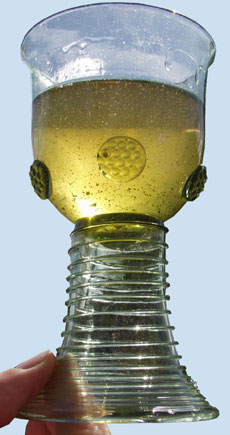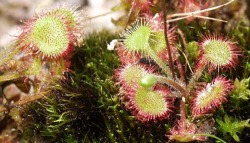Title.

A glass of Usquebaugh Royal, a saffron coloured cordial containing tiny flecks of gold. Note how the glass is being gripped by the foot, the correct way of holding a glass in the seventeenth and early eighteenth century.
Usquebaugh is one of the earliest English cordial waters and dates from the Tudor period. It retained its popularity well into the nineteenth century. By this time it had become a popular drink on the continent. It even turned up in eighteenth century Naples, where it was known in the cafes as scumba all' inglese. Most cordials were of continental origin and many, like rosa solis, were first produced by Italian Renaissance apothecaries. This explains why they are frequently referred to in French confectionery texts as Liqueurs d’ltalie. However, a number of British ‘sweet drams’ achieved popularity on the other side of the Channel. Most important of these was a more down-market relative of Royal Usquebaugh. Known in France as Escubac d’Angleterre, this lacked the flecks of gold leaf, but was nevertheless a popular drink. The word whisky is derived from the Irish usquebaugh, which is literally the Gaelic translation of Latin aqua vitae, the water of life. But usquebaugh consumed in seventeenth and eighteenth century England and France bore no resemblance to the spirit we now call whisky. It was a spicy, bright yellow cordial, usually flavoured with aniseed, liquorice and saffron and sweetened with fruit sugar extracted from figs and raisins by maceration.
The Origin

The carnivorous plant Sundew (Drosera rotundifolia L.) was used to create a bright yellow cordial water called rosa solis or rosolio. This strong spirit seems to have originated in Renaissance Turin and was initially esteemed as a medicine and aphrodisiac before it became a popular drink.
